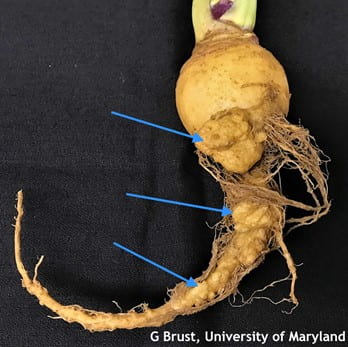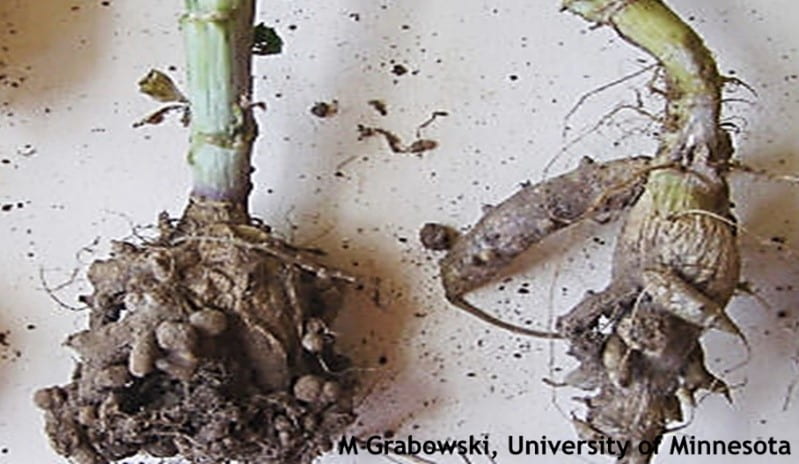Jerry Brust, IPM Vegetable Specialist, University of Maryland; jbrust@umd.edu
It is odd that we would have a couple reports of an unusual disease of brassicas turn up in the same week, but we did. Clubroot, caused by Plasmodiophora brassicae, is a major disease of brassica, i.e., broccoli, cabbage, turnip, rutabaga, and radish. It can also infect weeds in the mustard family as well as some grasses. This soil-borne fungus infects susceptible plants through their root hairs. Diseased roots become swollen, misshapen and deformed (clubbed or galled) often cracking and rotting (Fig. 1). As a result, plants have difficulty absorbing water and nutrients. The symptoms can at times look similar to root knot nematode damage and you would need to send a sample into a diagnostic lab to be sure.
Infected roots enlarge to form galls that differ in size and shape depending on the host plant. On crops with fleshy roots such as rutabaga and turnip, galls form on the taproot or secondary roots (Fig. 1). Crops with fibrous roots such as cabbage and broccoli produce club-like, spindle-shaped swellings on individual roots (Fig. 2). The disease can be well established in the roots before any above ground symptoms are apparent. At first plants will grow poorly and wilt during the heat of the day but recover at night. Outer leaves may turn yellow or brown. Root galls are often invaded by secondary organisms causing root decay and the death of the plant. Club root can reduce yields and at times cause total crop failure.
Disease development occurs over a wide range of conditions, but is favored by excessive moisture, low soil pH (below 6.5) and soil temperatures between 64 and 77 °F (warmer soils increase disease severity with a minimum soil temperature of 57 °F being needed). The repeated production of brassica crops in the same field can lead to a rapid build-up of the pathogen. Spores can survive in the soil for as many as 10-20 years. The disease is spread by drainage water, infested soil on equipment and tools and infected transplants.
Clubroot can be difficult to manage because the pathogen produces thick-walled, long-lived spores. Although there are reports that suggest clubroot spores can live for as long as 20 years, enough spores are expected to die within 5 to 7 years to make this (5-7 years) a more realistic rotation period. Even so, the pathogen is unlikely to be eradicated once established in a field. Some things that can be done culturally to help reduce its severity are to maintain a ‘high’ pH (>7.1) using calcitic lime instead of dolomitic, except where magnesium levels are very low. While liming will not eliminate clubroot problems in the field, it can significantly reduce infection rate and disease severity. Because a high pH can lead to boron deficiency in sandy soils, boron may be needed as a foliar spray. In addition to pH changes, growers can improve soil drainage, so there is little waterlogging or run-off, reduce any brassica weeds both during the growing season and between seasons and make sure transplants are clean. Although resistant cultivars are available they might not fit into a grower’s production practices. Resistant cultivars should be used in combination with other methods of clubroot control.
Because infected plants may show no obvious aboveground symptoms or yield loss when disease severity is low or moderate it is recommended to randomly dig a few plants up and inspect their roots for galls if your farm has any history of clubroot.
- Figure 1. Club root disease on rutabaga, galls on main tap root (arrows)
- Figure 2. Club root disease on fibrous crucifer roots


